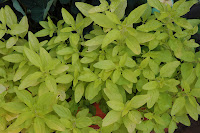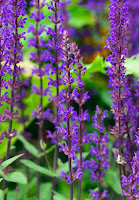I'm currently waiting for a landscape contractor to come round to quote on some jobs that need doing, so thought I'd get up to date on my blog. Yesterday was dry so spent some time in the back garden picking up some slugs and snails that were lying on the surface of the beds that I had treated with Slug Clear liquid concentrate the day before. For the last two years I've tried all kinds of organic methods, including beer traps, but this year the slugs and snails were totally out of control as every newly bought plant or seedling I planted had a near zero survival rate. It feels even worse when it is something I have raised and nurtured from seed. I don't grow food, only ornamentals, so something that actually worked was urgently needed.
I have never wanted to use pellets as animals eat them, and this stuff just dilutes in the watering can although you have to pick a day when rain isn't forecast and re-apply after heavy rains. I was really surprised how well it worked and got rid of dozens of slugs and snails the following day, so I definitely recommend this product. It was quite a fun job too finding them all on the surface in broad daylight to easily dispose of as I'm not one of those people who would go looking for them after dark with a flashlight to catch them in the act of nibbling.
Then this morning some plants arrived that I'd ordered online, mainly hardy geraniums and Japanese anemones as I have some shady beds to fill.
Anemone x hybrida 'Whirlwind' is a double white autumn flowering anemone that grows up to nearly 3ft tall and spreads rapidly. This is for the small corner bed where I have a black lace elder bush growing and needed something white to brighten up this corner under the shade of my neighbours tree. The stone retaining wall adjoining this bed will prevent it spreading beyond this corner bed.
Anemone hupehensis 'Praecox' is a deep pink colour, grows to 2ft tall with single flowers darker than most pink forms from August - October.
Praecox is earlier than other summer blooming anemones.
This one is for the west border near the deck, as there is plenty of space for it to spread.
Anemones like fertile, humus-rich soil. They like slightly drier conditions before flowering in early summer, as well as in winter.
Anemone x hybrida 'September Charm' has single rosy pale pink flowers and grows to about 2 feet tall. Flowers July to September/Oct.
This one is going in the 'woodland bed' at the back of the deck, which is one of the shadiest beds but gets some dappled light throughout the day. I have a pale fuschia that is growing there and I love the way the pale colours really stand out in the lower light.
Of the new hardy geraniums to try out I have the following:
Geranium sylvaticum 'Mayflower' Grows best in a semi-shaded woodland garden. This will also go in my 'woodland bed' behind the deck which really needs filling out. It is 45cm (18in) tall and flowers May/June.
Geranium 'Sweet Heidi' grows to 12 to 18 inches tall and has a semi-trailing habit, so good for slopes and hanging baskets too. It flowers briskly cover up to 2 1/2 feet of ground, repeating for months on end in full sun in northern climates, part shade farther south. I'll use this one in a bed that gets a little bit more sun, probably to underplant my roses.
All of the above are perennials and easy maintenance plants.
Back to the slugs and snails though, they have eaten all the leaves off of my new Salvia nemorosa ‘Caradonna’ which I only just planted and spoke about in my last post, along with the newly planted aubretia and lobelia. And this is in the gravel garden where there is all that sharp stone and grit. I dug up the leafless Salvia and now have it in a pot in my utility room, where I hope I can help it recover although I don't have high hopes for it. If we get a few consecutive days with no rain forecast I'm really looking forward to applying another dose of Slug Clear, which also deals with snails, and can see this becoming a favourite pastime of mine.
Back to the slugs and snails though, they have eaten all the leaves off of my new Salvia nemorosa ‘Caradonna’ which I only just planted and spoke about in my last post, along with the newly planted aubretia and lobelia. And this is in the gravel garden where there is all that sharp stone and grit. I dug up the leafless Salvia and now have it in a pot in my utility room, where I hope I can help it recover although I don't have high hopes for it. If we get a few consecutive days with no rain forecast I'm really looking forward to applying another dose of Slug Clear, which also deals with snails, and can see this becoming a favourite pastime of mine.










